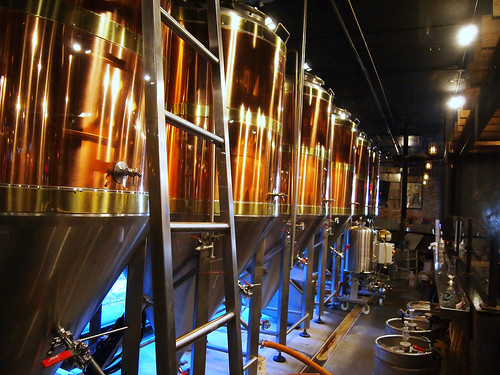Copper was a metal long valuable in the construction of breweries, but is now laregely replaced by stainless steel. Copper is malleable and can be formed into sheets, which allowed the engineering of large brewing vessels. The sheets were easily joined to produce leak-proof seals. Copper is an excellent conductor of heat, which made it the metal of choice in the days when direct firing of kettles was common. In Britain, brewing kettles are still sometimes referred to as "coppers."— The Oxford Companion to Beer: Oxford University Press, 2012.
In a brewery, copper gleams mighty pretty but it can discolor mighty ugly. It oxidizes.
Fortuitously, brewers long have had a cleaning product readily at hand. They polished their copper kettles with spent yeast and a mild abrasive (such as the ash from the fire under the kettles).
Today's kettles are fabricated from stainless steel and heated by steam in wrap-around stainless-steel 'jackets'. But, for good looks, many 'craft' brewery kettles are gift-wrapped with sheets of copper on their exteriors. Today's brewers polish them not with yeast, but with chemical cleaners, most of which are acid-based.
Today's fermentation tanks are also constructed of stainless steel; many fashion-wise 'craft' breweries copper-clad those as well. Such as Max Lager's Wood-Fired Grill & Brewery in midtown Atlanta, Georgia, whose tanks, pictured above, were each beautifully polished.
I didn't ask the brewers how they cleaned their tanks and kettle. I simply admired the sheen, and enjoyed lunch and a beer(s).
-----more-----
- Photo taken at Max Lager's on 1 December 2016. More photos: here.
- Pic(k) of the Week: one in a weekly series of photos, usually posted on Saturdays, and often, but not always, with a good fermentable as the subject.
- Camera: Olympus Pen E-PL1.
- Commercial reproduction requires explicit permission, as per Creative Commons.
- For more from YFGF:
- Follow on Twitter: @Cizauskas.
- Like on Facebook: YoursForGoodFermentables.
- Follow on Flickr: Cizauskas.
- Follow on Instagram: @tcizauskas.










No comments:
Post a Comment
Comment here ...